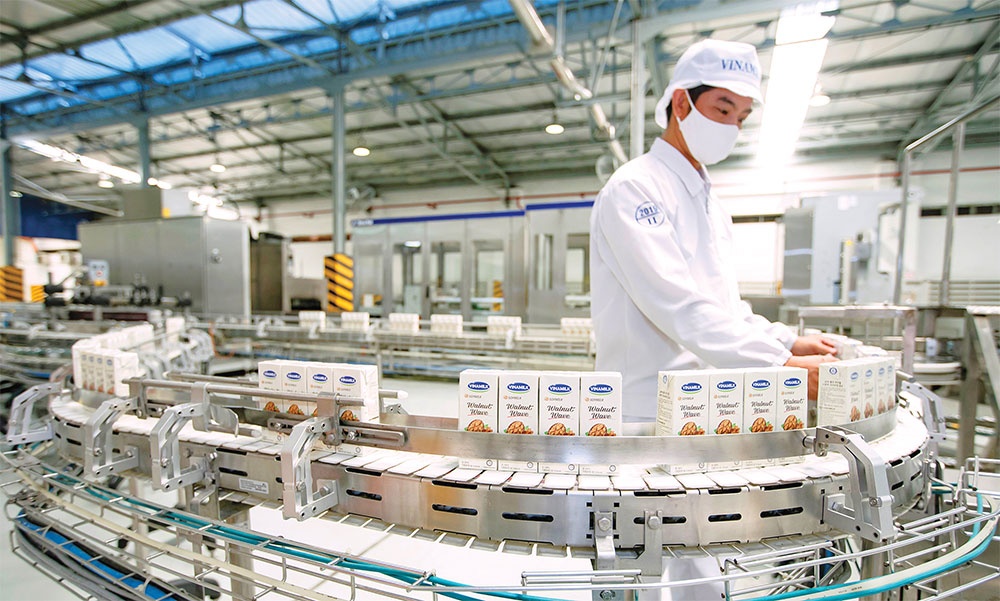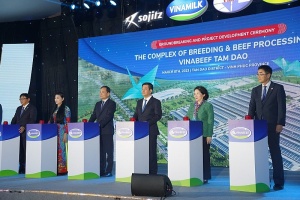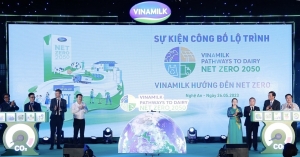Food businesses seeking brand new growth engines
 |
| Vinamilk is undergoing a facelift in order to move with the times, photo Le Toan |
After nearly 50 years in the business, Vinamilk, the 6th valuable brand in the world, has decided to change its brand identity. According to CEO Mai Kieu Lien, the rebranding campaign is a part of the company’s next five-year strategy, which includes digital transformation in all sectors that aim to reach and engage with consumers faster and more efficiently. Since its establishment, Vinamilk has changed many times its brand identity and this time is no exception.
“A brand that wants to last 100 or 200 years must change in accordance with actual conditions. During our years of development, Vinamilk has undergone numerous changes, and this time is no exception” Lien shared.
Vinamilk, the 36th largest dairy company in the world in revenue terms, currently owns about 40 percent of the dairy market share in Vietnam, with about 15 dairy cow farms, 17 processing factories out of a total of nearly 50 domestic and overseas subsidiaries.
After tough recent years due to the pandemic, the company recorded consecutive profit growth in the first two quarters of this year. It has successfully signed several large export contracts with a total value of USD 100 million and is eyeing positive growth in the second half. By the end of June, Vinamilk had achieved revenue of nearly $1.2 billion and profit after tax of more than $173 million, of which revenue in the second quarter increased by 16.5 percent compared to the first quarter.
Viet Capital Securities forecasts Vinamilk’s revenue will achieve a compound annual growth rate of 6 percent over the next four years.
“Vinamilk will focus on meeting the needs of consumers across quality, price, and service to increase sales and market share,” Lien said
According to the Ministry of Industry and Trade (MoIT), about 5,000 Vietnamese enterprises are currently operating in the food and beverage industry, an increase of 83.8 percent compared to before the pandemic.
Over the last five years, the volume of food and beverage consumption in the country has risen by 9.68 percent and 6.66 percent, according to the MoIT.
“We consider that there is a lot of growth potential for AB Mauri in the country. Our current business in Vietnam is strong, but there is still much room for growth to be in line with the market potential,” said Tran Huu Dat, the new CEO of AB Mauri Vietnam, a subsidiary of Associated British Foods Group.
Dat said the Vietnamese confectionary industry had been experiencing double-digit annual growth due to the contribution from both local and foreign businesses, competing through innovation, quality, pricing, and local understanding.
To realise this growth, one of the company’s strategic priorities is to expand its bakery ingredients business. This strategy began with the appointment of a new CEO at AB Mauri Vietnam, while participating deeper in the domestic market as well as aiming to supply bakery ingredients to other countries in the region.
“We are exploring different possibilities to realise this growth, including long-term investment in raw materials,” he said.
The food industry has a stable growth rate of about 7 per cent per year and more than half of businesses operating in this sector are participating in foreign direct investment, according to the MoIT.
 | Vinamilk and Kido joint venture disbanded Vibev, an ice cream and non-alcoholic beverage company owned by Vinamilk (51 per cent) and Kido (49 per cent), has announced its dissolution after more than two years. |
 | Vinamilk and Sojitz kick off Vinabeef Tam Dao The Vinabeef Tam Dao breeding and processing complex is the first project in the investment and collaboration plan between Vietnamese and Japanese high-tech agriculture corporations Vinamilk, Vilico, and Sojitz. |
 | Vinamilk receives BSI nod for carbon-neutrality efforts Vinamilk has just received validation from a British standards' authority for its pioneering efforts in the Vietnamese dairy industry to establish carbon-neutral factories and farms. The ongoing initiative is part of the company's Net Zero by 2050 goal. |
What the stars mean:
★ Poor ★ ★ Promising ★★★ Good ★★★★ Very good ★★★★★ Exceptional
 Tag:
Tag:
Related Contents
Latest News
More News
- Businesses ramp up production as year-end orders surge (December 30, 2025 | 10:05)
- Vietjet chairwoman awarded Labour Hero title (December 29, 2025 | 13:06)
- How to unlock ESG value through green innovation (December 29, 2025 | 10:03)
- AI reshapes media and advertising industry (December 29, 2025 | 08:33)
- FPT and GELEX sign deal to develop blockchain tech for global markets (December 29, 2025 | 08:29)
- Vietnam’s GDP forecast to grow by 9 per cent in 2026 (December 29, 2025 | 08:29)
- Women entrepreneurs are key to Vietnam’s economic growth (December 29, 2025 | 08:00)
- Vietnam's top 500 value-creating enterprises announced (December 27, 2025 | 08:00)
- The PAN Group shaping a better future with ESG strategy (December 26, 2025 | 09:00)
- Masan Consumer officially lists on HSX, marking the next phase of value creation (December 25, 2025 | 13:20)























 Mobile Version
Mobile Version